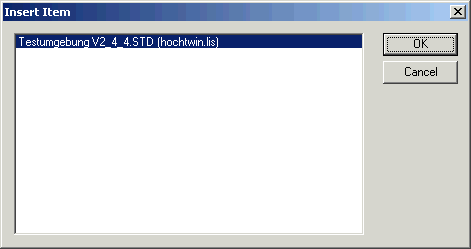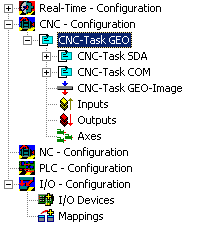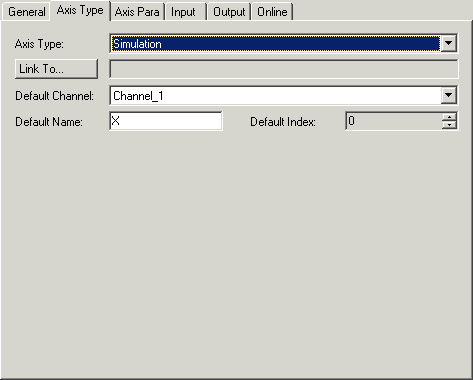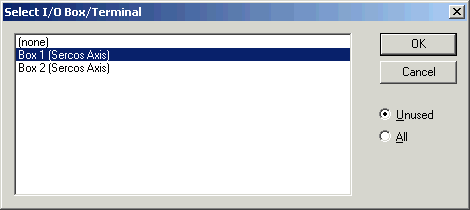Configuration of the CNC kernel in the TwinCAT System Manager
The basic configuration of the CNC kernel is carried out in the TwinCAT System Manager. The System Manager is used as usual for all settings that also apply to other system components and for the complete I/O configuration of the CNC kernel.
After the installation of TwinCAT CNC, an additional top-level entry ("CNC configuration") will appear in the System Manager tree. CNC functions are activated by appending a "CNC task" below the CNC configuration (e.g. via the context menu of the CNC configuration). Once an appropriate name for the task has been entered, a prototype file for the general configuration of the CNC kernel can be specified.

The selected prototype file is copied into the System Manager configuration and can be edited if required. The System Manager automatically adjusts the configuration file entries required for the basic configuration. The System Manager tree now has the following structure:

3 tasks, 1 process image and 1 axis group (currently not containing any axes) were created. The first task ("GEO CNC") operates in the interpolation cycle of the CNC. Among other tasks, it calculates the respective set values for the axes and controls the axes, if necessary. This task should have the highest priority in the system. The "SDA CNC task" deals with decoding and processing of the NC programs and should therefore have a lower priority than the GEO task. The "COM CNC task" deals with the communication integration of the CNC kernel. This task manages all ADS jobs.
To operate the CNC kernel, at least one axis and one channel must be created. Channels are appended as sub-elements below the "GEO CNC task" (e.g. via context menu). While channels are appended, prototype configuration files are queried, which may already contain an outline configuration for the channel. Prototype files for SDA data, zero offset data, location offset data, and - if no external tool management system is active - for tool data are queried.
Axes are created below the axis group. Here too, a prototype file is requested that may already contain specific configuration for the respective axis type. Like in the main configuration file of the CNC kernel, the TwinCAT System Manager controls some entries in the configuration files for axes and channels. This ensures a consistent configuration that matches other system components.
Axis configuration
Once axes have been inserted, their axis type is automatically set to simulation mode, and the axes have no I/O connection. This can be changed via the axis type tab of the respective axis. In the first step, the desired axis type has to be selected. The following axis types are currently available:
- Simulation
- SERCOS interface
- Profibus (in synchronous operation, with or without "dynamic servo control" (DSC))

Process data
Once the desired axis type has been selected (except for simulation axes), it can automatically link to the appropriate drive device. This device must previously have been created in the System Manager. Also, the process data of the respective drive device should already have been configured since they are read into the CNC configuration.
Via the link button, a list of available drive devices that are compatible with the selected axis type can be called up:

Once a device has been selected, the process data are read into the CNC axis and linked. Furthermore, suitable entries are made in the axis configuration file indicating the layout and type of the process data to the CNC kernel.
Channel assignment
During configuration, each axis can be assigned a channel. This is a default assignment, which can be changed at run time. Apart from the specification of the associated channel, the channel assignment also includes the axis identifier for the axis within NC programs for this channel, and the channel-specific axis index.